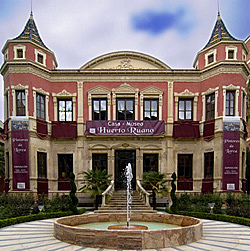Casa-Museo Huerto Ruano exhibition venue in Lorca
The Huerto Ruano is the best example of Modernist and Eclectic architecture in Lorca
The Palacete Huerto Ruano is one of the more recent palatial residences built by the wealthy and the  aristocracy in Lorca, and dates from the 19th century, when Raimundo Ruano brought back to the city a taste for the architecture and culture of Edinburgh, where he had been away for a while in the course of his work.
aristocracy in Lorca, and dates from the 19th century, when Raimundo Ruano brought back to the city a taste for the architecture and culture of Edinburgh, where he had been away for a while in the course of his work.
The result is an eclectic Modernist building, which contains a little jewel inside in the form of the “neo-Nazarid” room, decorated in the style of the 1,000-year-old Moorish palace of the Alhambra in Granada.
The building was declared an Item of Cultural Interest in 1993, and is now used as an exhibition venue and museum.
History of the Palacete Huerto Ruano
Raimundo Ruano Blázquez was a wealthy businessman and politician who inherited the empire built by his father, and when he returned from Scotland he chose a site on the street known at the time as the Alameda de Espartero for his new palatial residence. Soon afterwards other wealthy families followed his lead, and the street was eventually renamed Avenida Juan Carlos I after the restoration of the monarchy in Spain following the death of General Franco in 1975.
Construction began in 1877 following the design of Francisco Navarro Alcaraz and under the supervision of Juan Gil, ending two years later, although interior decoration work continued until 1890.
But by 1903 the building had become home to a branch of the Banco de Cartagena, before in 1917 it was sold to Simón Mellado Benítez (Mayor of Lorca) and later to the Cachá family. Reforms followed in 1925, under the supervision of Modernist architect Víctor Beltrí. It did not come into the hands of the Town Hall of Lorca until 1996, and this in theory ensured that it would not gradually deteriorate: the paintings of Wssell de Guimbarda were restored and other restoration projects were undertaken, including the ornate gardens.
Unfortunately, though, more work was required as a result of the earthquakes which hit Lorca in May 2011.
Architectural features
The front of the two-floor building features two corner towers containing an extra storey with spires on the top, and in between them a curved cornice is decorated with a relief showing an angel resting on vegetation. The ground floor is stonework, while the first floor is finished in a brickwork effect.
The large ground floor windows are also decorated with floral reliefs and the main doorway and the two windows on either side are topped with arch-like designs, while similar effects are achieved on the first floor. Leading to the main door is a marble staircase.
On the first floor there are three balconies, a large one serving the three central windows and two smaller ones alongside.
Among the interior features the highlights include an imperial-style staircase with glass and bronze balustrades designed by Beltrí, while the paintings by Wssel de Guimbarda which adorn the entrance lobby and the staircase are allegorical representations of the Arts and the Four Seasons. There is also a dance hall, while the “meeting room” is the area decorated in the style of the Alhambra.
The gardens, surrounded by wrought iron railings, included sculptures of Industry and Agriculture next to the entrance gate, and a small pond at the centre of which is a sculpture of a young boy playing with a goose.
Location:
The Palacete Huerto Ruano is located on Avenida Juan Carlos I de Lorca at the corner with Calle Floridablanca.
Address: Avenida Juan Carlos I,
Telf: 968 44 19 14
Opening hours when exhibitions are in situ:
Monday to Friday 11.00 to 14.00 and 17.00 to 20.00. Closed at weekends.
Admission is free of charge.
Click here to see other cultural centres in Lorca as well as a full cultural agenda and further information about the city: LORCA TODAY
article_detail




 aristocracy in Lorca, and dates from the 19th century, when Raimundo Ruano brought back to the city a taste for the architecture and culture of Edinburgh, where he had been away for a while in the course of his work.
aristocracy in Lorca, and dates from the 19th century, when Raimundo Ruano brought back to the city a taste for the architecture and culture of Edinburgh, where he had been away for a while in the course of his work.

